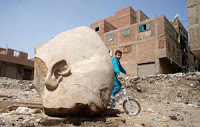Associated Press (AP World News, May 7, 2017); Editors, Wisdom Quarterly
 |
| The solid gold mask of King Tutankhamun is seen in its glass case in
the Egyptian Museum near Tahrir Square in Cairo, Egypt. Archaeologists
and conservation experts met in Cairo on Sunday, May 7, 2017, to discuss
the safe transportation of King Tut's artifacts (AP). |
.
 |
| There are Egyptian artifacts in the Americas |
CAIRO, Egypt - Archaeologists and conservation experts met in Cairo on Sunday (May 7) to discuss the safe transportation of King Tutankhamun's throne, chests, and bed from the Egyptian Museum in central Cairo to a new one being built on the other side of the country's capital.
The meeting, organized by the Egyptian Ministry of Antiquities, brought together experts from Egypt, France, Spain, Germany, Switzerland, Denmark, and Japan.
 |
| Ancient statue found in Egyptian slum |
Tareq Tawfiq, a senior ministry official in charge of the new museum, told The Associated Press that the meeting's primary objective was to reach a "global consensus" on how to safely transport and display King Tut's items in the new museum being built close to the famed Giza Pyramids.
 |
| Slum statue not Ramses II |
The meeting also discussed methods to display the human remains discovered in King Tut's tomb, particularly those belonging to his two daughters, both stillborn, according to a document distributed to participants.
 |
| New lab for pharaoh's boat |
"It's a very big challenge to move a collection, particularly of such importance," one of the participants, German Egyptologist Gabrielle Pieke, told the AP. Moving items belonging to King Tut has become a particularly sensitive issue since 2014, when the beard attached to the ancient Egyptian monarch's golden mask was accidentally knocked off during work on the relic's lighting.
 |
| There are bigger pyramids in Mexico, Bosnia... |
Workers later hastily tried to reattach it with an epoxy compound, causing damage to the priceless artifact and causing an uproar among archaeologists across the world.
A German-Egyptian team worked on the restoration of the mask, which was placed...
More






































































































































































































































No comments:
Post a Comment